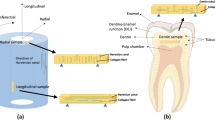Abstract
Mineralized tissues, such as bone and tooth dentin, serve as structural materials in the human body and, as such, have evolved to resist fracture. In assessing their quantitative fracture resistance or toughness, it is important to distinguish between intrinsic toughening mechanisms, which function ahead of the crack tip, such as plasticity in metals, and extrinsic mechanisms, which function primarily behind the tip, such as crack bridging in ceramics. Bone and dentin derive their resistance to fracture principally from extrinsic toughening mechanisms, which have their origins in the hierarchical microstructure of these mineralized tissues. Experimentally, quantification of these toughening mechanisms requires a crack-growth resistance approach, which can be achieved by measuring the crack-driving force (e.g., the stress intensity) as a function of crack extension (“R-curve approach”). Here this methodology is used to study the effect of aging on the fracture properties of human cortical bone and human dentin in order to discern the microstructural origins of toughness in these materials.
Similar content being viewed by others
References
T.L. Anderson, Fracture Mechanics Fundamentals and Applications (Boca Raton, FL: CRC Press LLC, 1995).
J.W. Melvin and F.G. Evans, “Crack Propagation in Bone,” Biomechanics Symposium ASME, 87–88 (New York, 1973).
W. Bonfield and P.K. Datta, Journal of Biomechanics, 9 (1976), pp. 131–134.
T.M. Wright and W.C. Hayes, Journal of Biomechanics, 10(7) (1977), pp. 419–425.
J.C. Behiri and W. Bonfield, Journal of Biomechanics, 22(8–9) (1989), pp. 863–867.
T.L. Norman et al., Advances in Bioengineering, Vol. 20, ed. R. Vanerby (New York: ASME, 1991), pp. 361–364.
R. De Santis et al., Journal of Materials Science: Materials in Medicine, 11 (2000), pp. 629–636.
R.K. Nalla et al., Biomaterials, 24(22) (2003), pp. 3955–3968.
D. Vashishth, Journal of Biomechanics, 37(6) (2004), pp. 943–946.
R.K. Nalla et al., Biomaterials 26(2) (2005), pp. 217–231.
K.J. Koester et al., Biomaterials, 29(10) (2008), pp. 1318–1328.
P. Zioupos, Materials Science and Engineering: C, 6(1) (1998), pp. 33–40.
H. Peterlik et al., Nature Materials, 5(1) (2006), pp. 52–55.
J. Yan et al., Bone, 40(2) (2007), pp. 479–484.
Q.D. Yang et al., Biomaterials, 27(9) (2006), pp. 2095–2113.
J.D. Currey, Bones, 2nd edition (Princeton, NJ: Princeton University Press, 2002).
D.H. Pashley, Scanning Microscopy, 3(1) (1989), pp. 161–174.
A.R. Ten Cate, Oral Histology-Development, Structure and Function (St. Louis, MO: Mosby, 1994).
D.F. Weber, Archives of Oral Biology, 19(2) (1974), pp. 163–168.
A.E. Porter et al., Biomaterials, 26(36) (2005), pp. 7650–7660.
J.H. Kinney et al., Biomaterials, 26(16) (2005), pp. 3363–3376.
D. Arola and R.K. Reprogel, Biomaterials, 26(18) (2005), pp. 4051–4061.
D. Bajaj et al., Biomaterials, 27(11) (2006), pp. 2507–2517.
R.O. Ritchie, Materials Science and Engineering, 103 (1988), pp. 15–28.
R.O. Ritchie, International Journal of Fracture, 100 (1999), pp. 55–83.
G. Fantner et al., Nature Materials, 4(8) (2005), pp. 612–616.
D. Vashishth et al., Journal of Biomechanics, 36(1) (2003), pp. 121–124.
Y. Yeni and T.L. Norman, J.Biomed.Mater.Res., 51 (2000), pp. 504–509.
G. Parasamian and T. Norman, Journal of Materials Science: Materials in Medicine, 12 (2001), pp. 779–783.
Y.N. Yeni and D.P. Fyhrie, Journal of Biomechanics, 36(9) (2003), pp. 1343–1353.
R.K. Nalla et al., Nature Materials, 2(3) (2003), pp. 164–168.
R.K. Nalla et al., Bone, 35(6) (2004), pp. 1240–1246.
Standard Test Method For Measurement of Fracture Toughness, E1820 (West Conshohocken, PA: American Society for Testing and Materials, 2006).
D.B. Burr et al., Journal of Biomechanics, 21(11) (1988), pp. 939–941.
Author information
Authors and Affiliations
Corresponding author
Rights and permissions
About this article
Cite this article
Koester, K.J., Ager, J.W. & Ritchie, R.O. Aging and fracture of human cortical bone and tooth dentin. JOM 60, 33–38 (2008). https://doi.org/10.1007/s11837-008-0068-1
Published:
Issue Date:
DOI: https://doi.org/10.1007/s11837-008-0068-1




